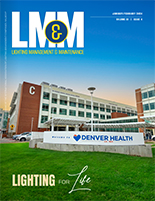Blue LEDs
The introduction of solid-state lighting using light-emitting diode (LED) technology has ignited widespread interest in the ways that lighting can offer benefits to people, including improved visibility at night, enhanced perceptions of brightness and security, and spectral tuning for management of circadian rhythms. Yet, as illustrated in a recent report from the American Medical Association (AMA), the increasing popularity of LED lighting is also raising new questions and reviving older concerns about unwanted impacts of these light sources, such as light pollution, discomfort glare, circadian disruption, and retinal damage via a mechanism known as blue-light hazard.
A new study from the Lighting Research Center (LRC) at Rensselaer Polytechnic Institute takes a practical, quantitative approach to evaluating light sources for blue-light hazard. Results of the study are published in the International Journal of Occupational Safety and Ergonomics, in an article titled, “Evaluating the Blue-Light Hazard from Solid State Lighting.”
In the study, LRC researchers John Bullough, Andrew Bierman and Mark Rea evaluate the spectral radiant power characteristics of incandescent, fluorescent, LED and daylight sources in terms of current blue-light hazard calculation procedures from the Illuminating Engineering Society and the Commission Internationale de l´Éclairage. The paper provides comparative data to allow meaningful and quantitative comparisons among light sources commonly experienced indoors and outdoors. Particular attention is given to use cases that could potentially affect blue-light hazard.
The study results showed that in the majority of use cases, LEDs do not exhibit greater risk for blue-light hazard than other light sources, including incandescent. LEDs present no special concerns for blue-light hazard over other common light sources in typical use cases because our natural photophobic responses, such as squinting and averting the gaze, limit exposure to bright light. Where photophobic responses might not occur, such as during eye surgery or with premature infants, caution is needed.
Some organizations, such as the AMA, have advised against using LEDs with correlated color temperature (CCT) exceeding 3000K, however, the LRC study found that avoiding blue-light hazard is primarily related to controlling the radiance of light sources, and much less related to spectral distribution, particularly when expressed in terms of CCT.
The LRC study authors note that CCT should not be used as a metric for characterizing the potential for blue-light hazard, citing the fact that an incandescent filament at 2856K within a clear bulb is associated with a greater risk for blue-light hazard than any white LED source, including one of 6500K. The spectral radiance distribution must be known to estimate blue-light hazard, particularly for those cases where photophobic responses might not occur. In these cases, and indeed for general lighting applications, the study authors recommend the use of lenses, baffles, and diffusers to mitigate glare as the primary methods for reducing the risk of blue-light hazard.
Learn More
About the Lighting Research Center
The Lighting Research Center (LRC) at Rensselaer Polytechnic Institute is the world’s leading center for lighting research and education. Established in 1988 by the New York State Energy Research and Development Authority (NYSERDA), the LRC has been pioneering research in solid-state lighting, light and health, transportation lighting and safety, and energy efficiency for nearly 30 years. LRC lighting scientists with multidisciplinary expertise in research, technology, design, and human factors, collaborate with a global network of leading manufacturers and government agencies, developing innovative lighting solutions for projects that range from the Boeing 787 Dreamliner to U.S. Navy submarines to hospital neonatal intensive-care units. LRC researchers conduct independent, third-party testing of lighting products in the LRC’s state of the art photometric laboratories, the only university lighting laboratories accredited by the National Voluntary Laboratory Accreditation Program (NVLAP Lab Code: 200480-0). In 1990, the LRC became the first university research center to offer graduate degrees in lighting and today, offers a M.S. in lighting and a Ph.D. to educate future leaders in lighting. With 35 full-time faculty and staff, 15 graduate students, and a 30,000 sq. ft. laboratory space, the LRC is the largest university-based lighting research and education organization in the world.
About Rensselaer Polytechnic Institute
Rensselaer Polytechnic Institute, founded in 1824, is America’s first technological research university. The university offers bachelor’s, master’s, and doctoral degrees in engineering; the sciences; information technology and web sciences; architecture; management; and the arts, humanities, and social sciences. Rensselaer faculty advance research in a wide range of fields, with an emphasis on biotechnology, nanotechnology, computational science and engineering, data science, and the media arts and technology. The Institute has an established record of success in the transfer of technology from the laboratory to the marketplace, fulfilling its founding mission of applying science “to the common purposes of life.”



